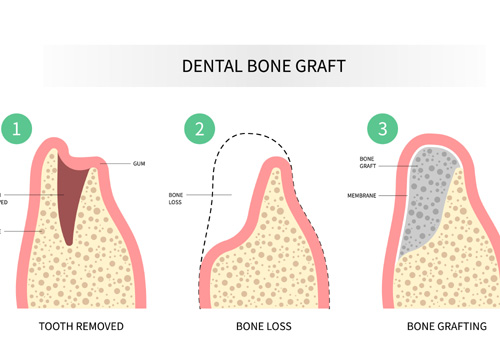Dental bone graft surgery is performed to increase the amount of bone in a part of the jaw where bone deterioration has occurred or where additional support is needed. Dental bone grafts can be made from a variety of materials, including bone taken from another part of the body or synthetic bone material. Dental bone grafts are sometimes needed for procedures such as dental implants if the bone deterioration has affected the health of the nearby gums and teeth.
Union City Oral Surgery Group is the top oral surgery facility in New Jersey because we prioritize providing the best of the best for our patients. Having state-of-the-art equipment and techniques is key to helping our patients get the oral help they need. Contact our office today to learn more about how we can help you improve your oral health.
What Is a Dental Bone Graft?
A dental bone graft adds volume and density to the jaw area where bone deterioration has occurred. There are several types of bone graft material, consisting of:
- Autografts: Bone tissue that is derived from another part of the body
- Alloplasts: Bone material made from hydroxyapatite (a naturally occurring mineral in bones)
- Allografts: Graft tissue that comes from a human donor (typically from a cadaver)
- Xenografts: Graft material obtained from animal bones (such as cows)
- Ceramic-Based Grafts: Material obtained from ceramics or a combination of ceramic and other materials like bioactive glass or calcium
Using natural bone for grafting has several advantages over synthetic materials, including better integration with existing bone and fewer complications.
The best material for your procedure depends on your needs. It’s important to discuss your options with an oral professional.
When is Bone Grafting Necessary?
Having a healthy jawbone is essential to our overall health, and bone grafts are often necessary to address bone loss resulting from factors like tooth loss, trauma, or medical conditions.
Bone grafts are often necessary for the following reasons:
To Save a Tooth
People suffering from severe periodontal (gum) disease often find their jaw and teeth also become affected. Periodontal disease can lead to teeth becoming loose or falling out. A dentist may repair or regenerate the surrounding bone with a bone graft to save the tooth. The bone graft provides the tooth with the extra support it needs to stay in place by promoting new bone growth.
To Prevent Facial Sagging
If dental conditions have caused the jawbone to thin or weaken, it needs to be repaired as soon as possible. A damaged jawbone left untreated can collapse, causing teeth to fall out and the facial structure to be damaged, which then leads to facial sagging. Bone grafts can stimulate new bone growth, helping to maintain the structure of the jawbone and prevent these issues.
Dental Implants
Jawbone loss is a major reason patients may not qualify for dental implant surgery. During a dental implant procedure, the implant is surgically attached to the jawbone of the missing or extracted tooth. If the patient doesn’t have a jawbone strong enough to support the implant, the implant may fall out. Dental implants require enough bone volume and density to function properly. Bone grafting procedures can augment and secure the jawbone to support dental implants.
Different Types of Dental Bone Graft Procedures
Dental bone grafting is essential for the successful placement of dental implants, maintaining oral health, and expanding treatment possibilities. There are four main types of dental bone graft procedures, including:
Socket Preservation
This type of bone graft is placed in the socket after a tooth extraction to fill the void left behind by the missing tooth. The procedure prevents the side of the socket from caving in and causing problems with the jawbone.
Proper care and hygiene are crucial during the healing process to ensure successful socket preservation.
Ridge Augmentation
If teeth have been missing for a while, the supporting jawbone could have thinned over time. A ridge augmentation increases the volume and width of the jawbone to make a more stable foundation for implants or other restorative options. This ridge augmentation is a surgical procedure designed to enhance the quality and volume of the jawbone, ensuring a stable foundation for dental implants.
Sinus Lift
The sinuses sit above the upper teeth. If the upper teeth are missing, the sinuses can drop down and invade the space meant to be occupied by the teeth roots. To address the problem, the sinus can be lifted and placed in its proper position. A dental bone graft is then placed underneath the sinus to create a solid foundation and keep the sinus in place.
Periodontal Bone Graft
Gum diseases can erode the bone supporting the teeth causing the teeth to loosen. A bone graft is placed around the existing teeth to procedure mobility and provides additional support to keep it in place.
Contact Union City Oral Surgery Group for Your Oral Health Needs
At Union City Oral Surgery Group, we will work hand-in-hand with you to create a treatment plan that addresses all your needs. Oral procedures can seem intimidating, especially because our mouth is so important to our everyday lives. Our oral professionals will make sure that you have the confidence and knowledge you need to approach your oral procedures without fear.
Union City Oral Surgery Group is determined to be there for our patients from beginning to end. Your needs are our top priority. Contact our office today by completing our online contact form or by calling (201) 601-9262.


